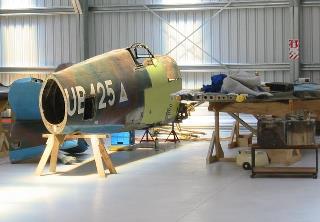 The
project has just moved into the ITL Aviation hangar at Fielding in
December 2003 ready for the project start. Although originally built at
the Castle Bromwich factory in September 1944, the aircraft had also been
re furbished in Israel. The restoration at ITL Aviation will return the
aircraft to "new", zero time condition The
project has just moved into the ITL Aviation hangar at Fielding in
December 2003 ready for the project start. Although originally built at
the Castle Bromwich factory in September 1944, the aircraft had also been
re furbished in Israel. The restoration at ITL Aviation will return the
aircraft to "new", zero time condition |
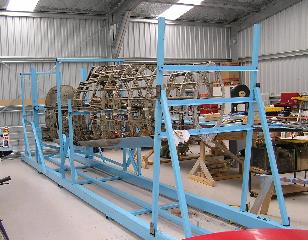 By
February 2004 the fuselage jig is being built up around the fuselage which
has had the outer skins removed. Around 25 years on a pole had taken its toll on
the lower fuselage in particular. The airframe had been attached to its
pole mount by bolts through the lower longerons which were then cut
through when it was removed By
February 2004 the fuselage jig is being built up around the fuselage which
has had the outer skins removed. Around 25 years on a pole had taken its toll on
the lower fuselage in particular. The airframe had been attached to its
pole mount by bolts through the lower longerons which were then cut
through when it was removed |
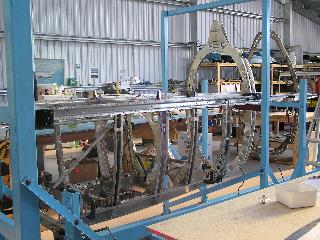 June
2004 and frame refurbishment is underway. Because of the way the aircraft
had been mounted for display, considerable damage had been done to the
bottom longeron behind the main join. Both bottom longerons have been
replaced with newly fabricated units June
2004 and frame refurbishment is underway. Because of the way the aircraft
had been mounted for display, considerable damage had been done to the
bottom longeron behind the main join. Both bottom longerons have been
replaced with newly fabricated units |
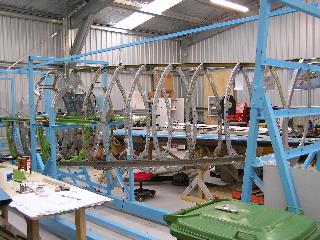 July
2004 and datum longerons have been re furbished and some frames. The
bottom longerons, datum longerons and top longeron form the main
longitudinal structure of the fuselage with the frames (from frame 5 the
firewall, to frame 19 where the tail section is bolted on) providing the
shaping for the skins. The Mk IX is essentially a Mk 5 with two stage
Merlin and heavier gauge skins as well as a number of minor modifications July
2004 and datum longerons have been re furbished and some frames. The
bottom longerons, datum longerons and top longeron form the main
longitudinal structure of the fuselage with the frames (from frame 5 the
firewall, to frame 19 where the tail section is bolted on) providing the
shaping for the skins. The Mk IX is essentially a Mk 5 with two stage
Merlin and heavier gauge skins as well as a number of minor modifications |
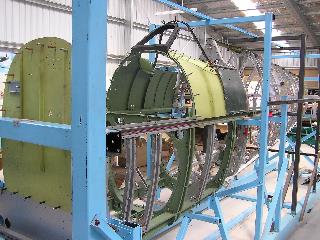 October
2004 and rebuild of the cockpit coming and part of frame 5 (which includes
the carry through spars) is nearing
completion. The firewall originally contained an asbestos fireproof
material between the sheet layers. In one of the few concessions to
progress, this has been replaced with a modern material. The area forward
of the cockpit housed the two fuel tanks. October
2004 and rebuild of the cockpit coming and part of frame 5 (which includes
the carry through spars) is nearing
completion. The firewall originally contained an asbestos fireproof
material between the sheet layers. In one of the few concessions to
progress, this has been replaced with a modern material. The area forward
of the cockpit housed the two fuel tanks. |
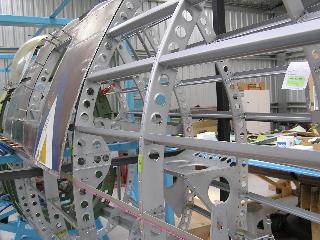 January
2005 - a number of fuselage frames have been refurbished, repaired
or replaced. Original skins are used to check alignment and fit. The
battery tray structure can be seen to the right of the rear fuselage. January
2005 - a number of fuselage frames have been refurbished, repaired
or replaced. Original skins are used to check alignment and fit. The
battery tray structure can be seen to the right of the rear fuselage. |
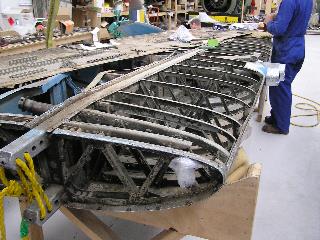 February
2005 - disassembly of one of the wings begins. Like the fuselage, the
wings will be completely stripped down to individual components. The main
components of each "D" section are the spars, spar webs and nose
ribs plus a myriad of other fixtures and fittings, virtually all Spitfire
specific February
2005 - disassembly of one of the wings begins. Like the fuselage, the
wings will be completely stripped down to individual components. The main
components of each "D" section are the spars, spar webs and nose
ribs plus a myriad of other fixtures and fittings, virtually all Spitfire
specific |
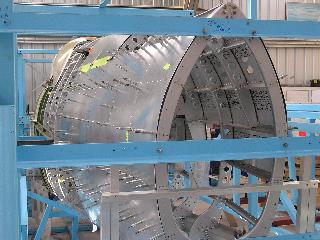 August
2005 - fuselage structure completed and re skinning of the fuselage has
started in earnest. Sheet to the original specification has been sourced
from England to maintain the authenticity of the rebuild August
2005 - fuselage structure completed and re skinning of the fuselage has
started in earnest. Sheet to the original specification has been sourced
from England to maintain the authenticity of the rebuild |
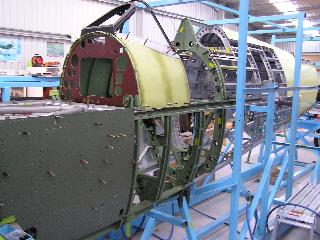 October
2005 - fuselage taking shape. The rebuild of PV270 has been as faithful to
the original factory specification as is possible and original materials
are used throughout - including British aluminum, rivets and AGS
fittings October
2005 - fuselage taking shape. The rebuild of PV270 has been as faithful to
the original factory specification as is possible and original materials
are used throughout - including British aluminum, rivets and AGS
fittings |
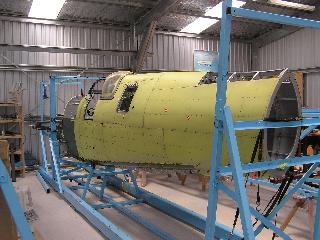 December
2005 - fuselage skinning largely complete. Access doors left off to
assist access to the inside structure. The "shape" of the
Spitfire is complex requiring a number of curved panels to be
"wheeled" into shape using the same techniques used in wartime
Spitfire production. December
2005 - fuselage skinning largely complete. Access doors left off to
assist access to the inside structure. The "shape" of the
Spitfire is complex requiring a number of curved panels to be
"wheeled" into shape using the same techniques used in wartime
Spitfire production. |
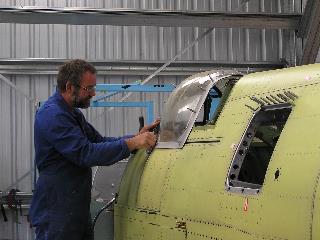 February
2006 - Pete Burgess working on the alignment of the rebuilt canopy. The
canopy guide on the port side includes a section fitted to the cockpit
door. The latch assembly on the door could be set to have the door
partially open which in turn stopped the canopy slipping forward in the
event of a take off accident February
2006 - Pete Burgess working on the alignment of the rebuilt canopy. The
canopy guide on the port side includes a section fitted to the cockpit
door. The latch assembly on the door could be set to have the door
partially open which in turn stopped the canopy slipping forward in the
event of a take off accident |
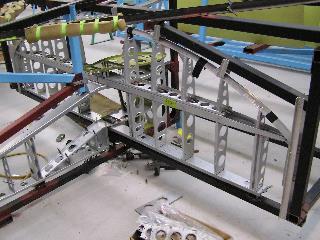 March
2006 - Tail section taking shape in the jig. Key elements such as spars
were re built because of corrosion to the originals March
2006 - Tail section taking shape in the jig. Key elements such as spars
were re built because of corrosion to the originals |
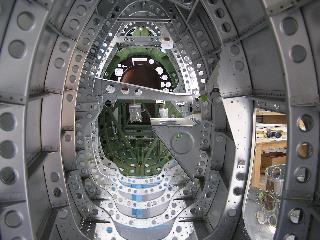 May
2006 - looking forward into the rebuilt fuselage with pilots seat fitted
and empty instrument panel. The structure midway down the fuselage was the
support for the slide in radio tray allowing it to be easily removed for
servicing. An original TR1143 radio set as fitted to this aircraft in the
factory has been obtained for historical completeness (although modern
radio, transponder and ELT will be fitted) May
2006 - looking forward into the rebuilt fuselage with pilots seat fitted
and empty instrument panel. The structure midway down the fuselage was the
support for the slide in radio tray allowing it to be easily removed for
servicing. An original TR1143 radio set as fitted to this aircraft in the
factory has been obtained for historical completeness (although modern
radio, transponder and ELT will be fitted) |
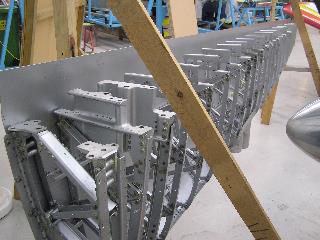 July
2006 - one of the wing "D" sections rebuilt and waiting to be
mated with the spars and spar webs. The leading edge skins are one piece
and "wheeled" into the complex shape required. The "D"
sections are the key to the enormous strength of the Spitfire wing July
2006 - one of the wing "D" sections rebuilt and waiting to be
mated with the spars and spar webs. The leading edge skins are one piece
and "wheeled" into the complex shape required. The "D"
sections are the key to the enormous strength of the Spitfire wing |
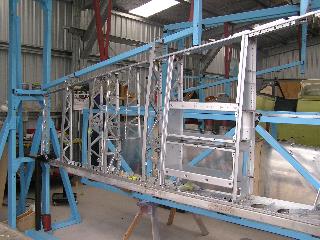 August
2006 - starboard wing structure after refurbishment and being trial
assembled using the original spars. The structure for the ammunition
magazines for the Browning machine guns can be seen in the centre.
Although new main and rear spars have been fabricated, the spar webs and
most of the wing ribs have been restored August
2006 - starboard wing structure after refurbishment and being trial
assembled using the original spars. The structure for the ammunition
magazines for the Browning machine guns can be seen in the centre.
Although new main and rear spars have been fabricated, the spar webs and
most of the wing ribs have been restored |
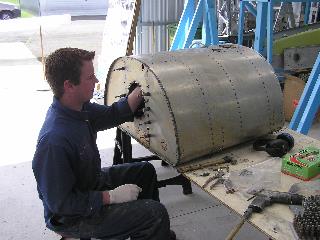 September
2006 - Joe Deere working on the upper one of the two fuel tanks. Total
fuel capacity is only 85 gallons so additional tanks are to be fitted
where the cannons were originally mounted on the aircraft. This will
almost double the range of the aircraft. Only the bottom tank was gauged
so no indication of fuel remaining was given to the pilot until the top
tank was empty September
2006 - Joe Deere working on the upper one of the two fuel tanks. Total
fuel capacity is only 85 gallons so additional tanks are to be fitted
where the cannons were originally mounted on the aircraft. This will
almost double the range of the aircraft. Only the bottom tank was gauged
so no indication of fuel remaining was given to the pilot until the top
tank was empty |
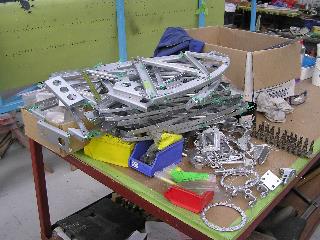 November
2006 - These
components are from one of the wing "D" sections. They are
mostly original parts with some new replacements built where the originals
were damaged. The original components are bead blasted to remove surface
corrosion, inspected/crack tested, re anodised and painted before returning to the airframe November
2006 - These
components are from one of the wing "D" sections. They are
mostly original parts with some new replacements built where the originals
were damaged. The original components are bead blasted to remove surface
corrosion, inspected/crack tested, re anodised and painted before returning to the airframe |
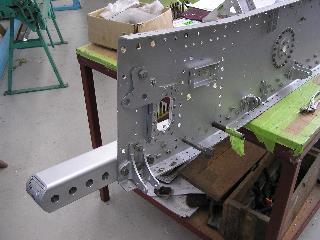 December
2006 - new spars being mated with the spar webs prior to joining with the
previously completed "D" sections. Each wing has two spars which
are made of multiple sections fitting inside each other and then bent to
achieve the required wing dihedral. The assemblies also carry the fittings
to attach the wing ribs. The spar sections reduce the further out on
the wing, starting with six and dropping down to half of one section at
the wing tip December
2006 - new spars being mated with the spar webs prior to joining with the
previously completed "D" sections. Each wing has two spars which
are made of multiple sections fitting inside each other and then bent to
achieve the required wing dihedral. The assemblies also carry the fittings
to attach the wing ribs. The spar sections reduce the further out on
the wing, starting with six and dropping down to half of one section at
the wing tip |
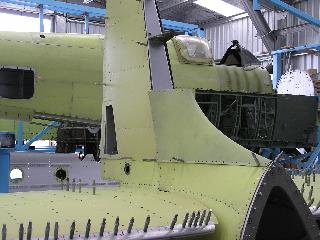 January
2007 - tail section rebuild nearing completion with completed fuselage in
the background. Fuselage belly skins, access doors and some side panels have been
completed but left off to
enable access for wiring and systems fit out. The bottom skins on the tail
plane include fixing by brass screws to wooden bearers as there
was no access for riveting January
2007 - tail section rebuild nearing completion with completed fuselage in
the background. Fuselage belly skins, access doors and some side panels have been
completed but left off to
enable access for wiring and systems fit out. The bottom skins on the tail
plane include fixing by brass screws to wooden bearers as there
was no access for riveting |
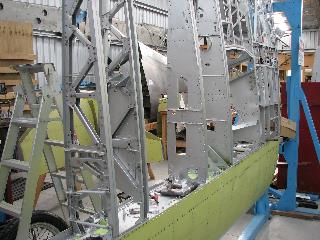 February
2007 - starboard wing ribs and structure being assembled onto the
completed starboard "D" section. Because of the good condition
of the original wings, virtually all of the fittings associated with the
mounting of the machine guns and cannons have been preserved, including
the adjusters used to harmonise and aim the guns February
2007 - starboard wing ribs and structure being assembled onto the
completed starboard "D" section. Because of the good condition
of the original wings, virtually all of the fittings associated with the
mounting of the machine guns and cannons have been preserved, including
the adjusters used to harmonise and aim the guns |
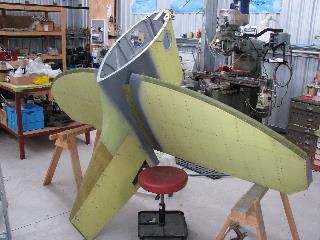 March
2007 - the tail section has been completed ready for internal control
fittings. Restoration of the rudder is progressing and restoration of the
elevator has yet to start March
2007 - the tail section has been completed ready for internal control
fittings. Restoration of the rudder is progressing and restoration of the
elevator has yet to start |
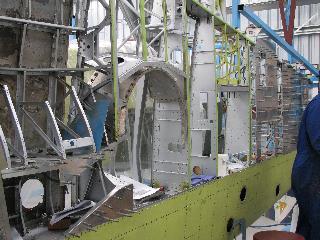 April
2007 - skinning has begun on the starboard wing April
2007 - skinning has begun on the starboard wing |
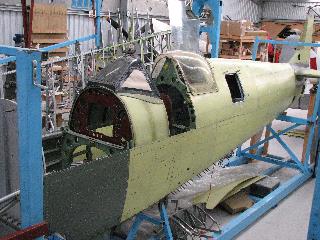 May
2007 - the completed tail assembly has been bolted to the main fuselage May
2007 - the completed tail assembly has been bolted to the main fuselage |
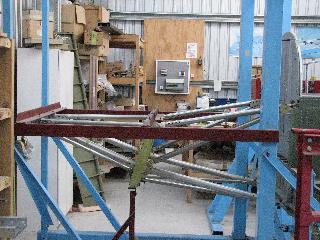 June
2007- The
engine mount assembly is fitted to the fuselage frame 5 and to the jig.
The tubular structure has to cope with the huge torsion loads imposed by
the 1,500 hp Merlin engine June
2007- The
engine mount assembly is fitted to the fuselage frame 5 and to the jig.
The tubular structure has to cope with the huge torsion loads imposed by
the 1,500 hp Merlin engine |
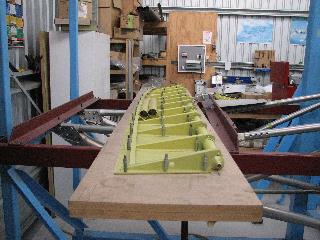 July
2007 - The
second of two newly built flaps nears completion July
2007 - The
second of two newly built flaps nears completion |
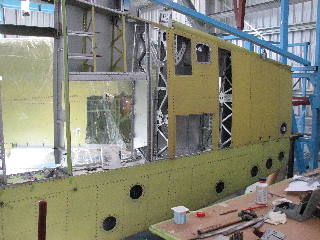 August
2007 - Wing skinning well advanced August
2007 - Wing skinning well advanced |
 September
2007 - trial fitting one of the radiator intake assemblies. Each intake
assembly houses two radiators - on one wing a coolant radiator and oil
cooler and on the other side another coolant radiator and the intercooler
radiator. September
2007 - trial fitting one of the radiator intake assemblies. Each intake
assembly houses two radiators - on one wing a coolant radiator and oil
cooler and on the other side another coolant radiator and the intercooler
radiator. |
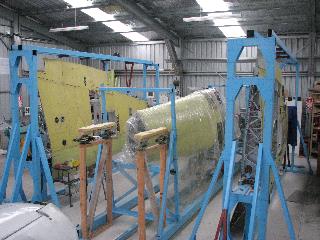 October
2007 - view of the fuselage and wings in their respective jigs with the
tail assembly removed for final shimming October
2007 - view of the fuselage and wings in their respective jigs with the
tail assembly removed for final shimming |
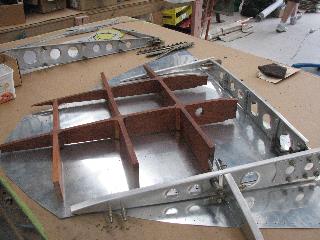 November
2007 - construction of the wing tips underway. November
2007 - construction of the wing tips underway. |
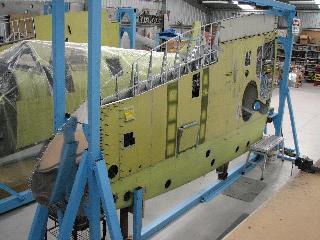 December
2007 - general view of progress at the end of the year December
2007 - general view of progress at the end of the year |
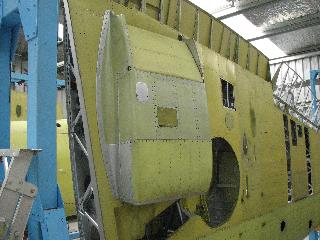 January
2008 - starboard wing with radiators and shroud fitted January
2008 - starboard wing with radiators and shroud fitted |
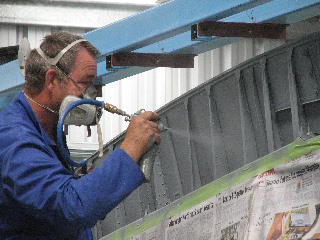 February
2008 - the medium sea grey final coat being applied to the underside of
the flap area February
2008 - the medium sea grey final coat being applied to the underside of
the flap area |
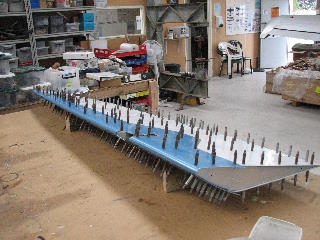 March
2008 - Port aileron nearing completion March
2008 - Port aileron nearing completion |
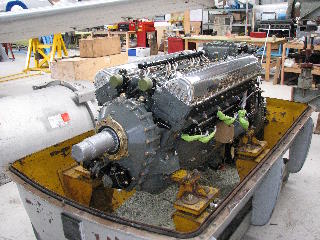 April
2008 - the arrival of our re furbished Merlin 70 engine was a significant
milestone April
2008 - the arrival of our re furbished Merlin 70 engine was a significant
milestone |
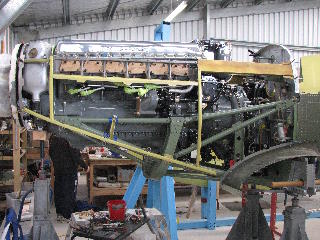 May
2008 - Engine is installed in airframe May
2008 - Engine is installed in airframe |
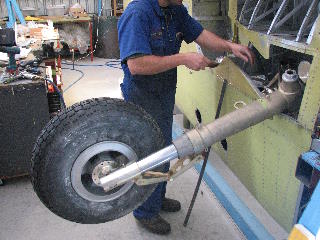 June
2008 - Undercarriage assemblies are aligned in wings June
2008 - Undercarriage assemblies are aligned in wings |
 By
February 2004 the fuselage jig is being built up around the fuselage which
has had the outer skins removed. Around 25 years on a pole had taken its toll on
the lower fuselage in particular. The airframe had been attached to its
pole mount by bolts through the lower longerons which were then cut
through when it was removed
By
February 2004 the fuselage jig is being built up around the fuselage which
has had the outer skins removed. Around 25 years on a pole had taken its toll on
the lower fuselage in particular. The airframe had been attached to its
pole mount by bolts through the lower longerons which were then cut
through when it was removed June
2004 and frame refurbishment is underway. Because of the way the aircraft
had been mounted for display, considerable damage had been done to the
bottom longeron behind the main join. Both bottom longerons have been
replaced with newly fabricated units
June
2004 and frame refurbishment is underway. Because of the way the aircraft
had been mounted for display, considerable damage had been done to the
bottom longeron behind the main join. Both bottom longerons have been
replaced with newly fabricated units July
2004 and datum longerons have been re furbished and some frames. The
bottom longerons, datum longerons and top longeron form the main
longitudinal structure of the fuselage with the frames (from frame 5 the
firewall, to frame 19 where the tail section is bolted on) providing the
shaping for the skins. The Mk IX is essentially a Mk 5 with two stage
Merlin and heavier gauge skins as well as a number of minor modifications
July
2004 and datum longerons have been re furbished and some frames. The
bottom longerons, datum longerons and top longeron form the main
longitudinal structure of the fuselage with the frames (from frame 5 the
firewall, to frame 19 where the tail section is bolted on) providing the
shaping for the skins. The Mk IX is essentially a Mk 5 with two stage
Merlin and heavier gauge skins as well as a number of minor modifications October
2004 and rebuild of the cockpit coming and part of frame 5 (which includes
the carry through spars) is nearing
completion. The firewall originally contained an asbestos fireproof
material between the sheet layers. In one of the few concessions to
progress, this has been replaced with a modern material. The area forward
of the cockpit housed the two fuel tanks.
October
2004 and rebuild of the cockpit coming and part of frame 5 (which includes
the carry through spars) is nearing
completion. The firewall originally contained an asbestos fireproof
material between the sheet layers. In one of the few concessions to
progress, this has been replaced with a modern material. The area forward
of the cockpit housed the two fuel tanks.  January
2005 - a number of fuselage frames have been refurbished, repaired
or replaced. Original skins are used to check alignment and fit. The
battery tray structure can be seen to the right of the rear fuselage.
January
2005 - a number of fuselage frames have been refurbished, repaired
or replaced. Original skins are used to check alignment and fit. The
battery tray structure can be seen to the right of the rear fuselage. February
2005 - disassembly of one of the wings begins. Like the fuselage, the
wings will be completely stripped down to individual components. The main
components of each "D" section are the spars, spar webs and nose
ribs plus a myriad of other fixtures and fittings, virtually all Spitfire
specific
February
2005 - disassembly of one of the wings begins. Like the fuselage, the
wings will be completely stripped down to individual components. The main
components of each "D" section are the spars, spar webs and nose
ribs plus a myriad of other fixtures and fittings, virtually all Spitfire
specific August
2005 - fuselage structure completed and re skinning of the fuselage has
started in earnest. Sheet to the original specification has been sourced
from England to maintain the authenticity of the rebuild
August
2005 - fuselage structure completed and re skinning of the fuselage has
started in earnest. Sheet to the original specification has been sourced
from England to maintain the authenticity of the rebuild October
2005 - fuselage taking shape. The rebuild of PV270 has been as faithful to
the original factory specification as is possible and original materials
are used throughout - including British aluminum, rivets and AGS
fittings
October
2005 - fuselage taking shape. The rebuild of PV270 has been as faithful to
the original factory specification as is possible and original materials
are used throughout - including British aluminum, rivets and AGS
fittings  December
2005 - fuselage skinning largely complete. Access doors left off to
assist access to the inside structure. The "shape" of the
Spitfire is complex requiring a number of curved panels to be
"wheeled" into shape using the same techniques used in wartime
Spitfire production.
December
2005 - fuselage skinning largely complete. Access doors left off to
assist access to the inside structure. The "shape" of the
Spitfire is complex requiring a number of curved panels to be
"wheeled" into shape using the same techniques used in wartime
Spitfire production. February
2006 - Pete Burgess working on the alignment of the rebuilt canopy. The
canopy guide on the port side includes a section fitted to the cockpit
door. The latch assembly on the door could be set to have the door
partially open which in turn stopped the canopy slipping forward in the
event of a take off accident
February
2006 - Pete Burgess working on the alignment of the rebuilt canopy. The
canopy guide on the port side includes a section fitted to the cockpit
door. The latch assembly on the door could be set to have the door
partially open which in turn stopped the canopy slipping forward in the
event of a take off accident March
2006 - Tail section taking shape in the jig. Key elements such as spars
were re built because of corrosion to the originals
March
2006 - Tail section taking shape in the jig. Key elements such as spars
were re built because of corrosion to the originals May
2006 - looking forward into the rebuilt fuselage with pilots seat fitted
and empty instrument panel. The structure midway down the fuselage was the
support for the slide in radio tray allowing it to be easily removed for
servicing. An original TR1143 radio set as fitted to this aircraft in the
factory has been obtained for historical completeness (although modern
radio, transponder and ELT will be fitted)
May
2006 - looking forward into the rebuilt fuselage with pilots seat fitted
and empty instrument panel. The structure midway down the fuselage was the
support for the slide in radio tray allowing it to be easily removed for
servicing. An original TR1143 radio set as fitted to this aircraft in the
factory has been obtained for historical completeness (although modern
radio, transponder and ELT will be fitted) July
2006 - one of the wing "D" sections rebuilt and waiting to be
mated with the spars and spar webs. The leading edge skins are one piece
and "wheeled" into the complex shape required. The "D"
sections are the key to the enormous strength of the Spitfire wing
July
2006 - one of the wing "D" sections rebuilt and waiting to be
mated with the spars and spar webs. The leading edge skins are one piece
and "wheeled" into the complex shape required. The "D"
sections are the key to the enormous strength of the Spitfire wing August
2006 - starboard wing structure after refurbishment and being trial
assembled using the original spars. The structure for the ammunition
magazines for the Browning machine guns can be seen in the centre.
Although new main and rear spars have been fabricated, the spar webs and
most of the wing ribs have been restored
August
2006 - starboard wing structure after refurbishment and being trial
assembled using the original spars. The structure for the ammunition
magazines for the Browning machine guns can be seen in the centre.
Although new main and rear spars have been fabricated, the spar webs and
most of the wing ribs have been restored September
2006 - Joe Deere working on the upper one of the two fuel tanks. Total
fuel capacity is only 85 gallons so additional tanks are to be fitted
where the cannons were originally mounted on the aircraft. This will
almost double the range of the aircraft. Only the bottom tank was gauged
so no indication of fuel remaining was given to the pilot until the top
tank was empty
September
2006 - Joe Deere working on the upper one of the two fuel tanks. Total
fuel capacity is only 85 gallons so additional tanks are to be fitted
where the cannons were originally mounted on the aircraft. This will
almost double the range of the aircraft. Only the bottom tank was gauged
so no indication of fuel remaining was given to the pilot until the top
tank was empty November
2006 - These
components are from one of the wing "D" sections. They are
mostly original parts with some new replacements built where the originals
were damaged. The original components are bead blasted to remove surface
corrosion, inspected/crack tested, re anodised and painted before returning to the airframe
November
2006 - These
components are from one of the wing "D" sections. They are
mostly original parts with some new replacements built where the originals
were damaged. The original components are bead blasted to remove surface
corrosion, inspected/crack tested, re anodised and painted before returning to the airframe December
2006 - new spars being mated with the spar webs prior to joining with the
previously completed "D" sections. Each wing has two spars which
are made of multiple sections fitting inside each other and then bent to
achieve the required wing dihedral. The assemblies also carry the fittings
to attach the wing ribs. The spar sections reduce the further out on
the wing, starting with six and dropping down to half of one section at
the wing tip
December
2006 - new spars being mated with the spar webs prior to joining with the
previously completed "D" sections. Each wing has two spars which
are made of multiple sections fitting inside each other and then bent to
achieve the required wing dihedral. The assemblies also carry the fittings
to attach the wing ribs. The spar sections reduce the further out on
the wing, starting with six and dropping down to half of one section at
the wing tip January
2007 - tail section rebuild nearing completion with completed fuselage in
the background. Fuselage belly skins, access doors and some side panels have been
completed but left off to
enable access for wiring and systems fit out. The bottom skins on the tail
plane include fixing by brass screws to wooden bearers as there
was no access for riveting
January
2007 - tail section rebuild nearing completion with completed fuselage in
the background. Fuselage belly skins, access doors and some side panels have been
completed but left off to
enable access for wiring and systems fit out. The bottom skins on the tail
plane include fixing by brass screws to wooden bearers as there
was no access for riveting February
2007 - starboard wing ribs and structure being assembled onto the
completed starboard "D" section. Because of the good condition
of the original wings, virtually all of the fittings associated with the
mounting of the machine guns and cannons have been preserved, including
the adjusters used to harmonise and aim the guns
February
2007 - starboard wing ribs and structure being assembled onto the
completed starboard "D" section. Because of the good condition
of the original wings, virtually all of the fittings associated with the
mounting of the machine guns and cannons have been preserved, including
the adjusters used to harmonise and aim the guns March
2007 - the tail section has been completed ready for internal control
fittings. Restoration of the rudder is progressing and restoration of the
elevator has yet to start
March
2007 - the tail section has been completed ready for internal control
fittings. Restoration of the rudder is progressing and restoration of the
elevator has yet to start April
2007 - skinning has begun on the starboard wing
April
2007 - skinning has begun on the starboard wing May
2007 - the completed tail assembly has been bolted to the main fuselage
May
2007 - the completed tail assembly has been bolted to the main fuselage June
2007- The
engine mount assembly is fitted to the fuselage frame 5 and to the jig.
The tubular structure has to cope with the huge torsion loads imposed by
the 1,500 hp Merlin engine
June
2007- The
engine mount assembly is fitted to the fuselage frame 5 and to the jig.
The tubular structure has to cope with the huge torsion loads imposed by
the 1,500 hp Merlin engine July
2007 - The
second of two newly built flaps nears completion
July
2007 - The
second of two newly built flaps nears completion August
2007 - Wing skinning well advanced
August
2007 - Wing skinning well advanced September
2007 - trial fitting one of the radiator intake assemblies. Each intake
assembly houses two radiators - on one wing a coolant radiator and oil
cooler and on the other side another coolant radiator and the intercooler
radiator.
September
2007 - trial fitting one of the radiator intake assemblies. Each intake
assembly houses two radiators - on one wing a coolant radiator and oil
cooler and on the other side another coolant radiator and the intercooler
radiator. October
2007 - view of the fuselage and wings in their respective jigs with the
tail assembly removed for final shimming
October
2007 - view of the fuselage and wings in their respective jigs with the
tail assembly removed for final shimming November
2007 - construction of the wing tips underway.
November
2007 - construction of the wing tips underway.  December
2007 - general view of progress at the end of the year
December
2007 - general view of progress at the end of the year January
2008 - starboard wing with radiators and shroud fitted
January
2008 - starboard wing with radiators and shroud fitted  February
2008 - the medium sea grey final coat being applied to the underside of
the flap area
February
2008 - the medium sea grey final coat being applied to the underside of
the flap area March
2008 - Port aileron nearing completion
March
2008 - Port aileron nearing completion April
2008 - the arrival of our re furbished Merlin 70 engine was a significant
milestone
April
2008 - the arrival of our re furbished Merlin 70 engine was a significant
milestone May
2008 - Engine is installed in airframe
May
2008 - Engine is installed in airframe June
2008 - Undercarriage assemblies are aligned in wings
June
2008 - Undercarriage assemblies are aligned in wings